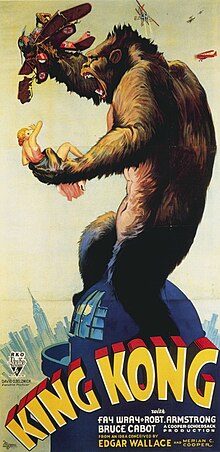 |
| Fig. 1 King Kong poster |
 |
| Fig. 2 King Kong bound |
Starting on a high, the tropical island's scenery is a focus point for the creativity of the film. The stop motion battle sequence of Kong and the dinosaur is a spectacle, regardless of the film's age, though it may seem more comedic now than when it first came out. The basis of the film lies entirely upon a puppet, which may seem a hefty task, but has warranted the film a remake. As John A. Nesbit said, "While difficult to conceive that a small "puppet" in the gigantic title role could carry the movie, that's what O'Brien achieves" (Nesbit, 2005). The reference to O'Brien is to the special effects designer, Willis O'Brien.
On a lower note, the story takes the backseat when introduced to the islands inhabitants. Apparently the word 'stealth' didn't exist in 1933, with the boarding party standing in the open oblivious to the consequences with the additional 'they've seen us' comment from the director who set up his tripod camera. And as to when Kong is bound on stage with an audience of people observing, you would expect the 'eighth wonder of the world' to have some sort of police presence, unless they thought a gigantic ape that had previously killed a dinosaur, killed most of the crew of the ship and fought off a raptor, posed no threat.
 |
| Fig. 3 King Kong fighting jets |
King Kong is "purely an exhibition of studio and camera technology-- and it isn't much more than that" (Bigelow, 1933). Willis O'Brien has captured the motion and emotion of Kong, standing as the highlight of the film, with the build up to Kong's appearance serving it's purpose well.
Illustration list
Figure 1. Ernest B. Schoedsack (1933) King Kong poster. At: http://upload.wikimedia.org/wikipedia/commons/thumb/f/f3/Kingkongposter.jpg/220px-Kingkongposter.jpg
Figure 2. Ernest B. Schoedsack (1933) King Kong bound. At: http://chosis.coldfusionvideo.com/wp-content/uploads/2011/03/king-kong-33_12.jpg
Figure 3. Ernest B. Schoedsack (1933) King Kong fighting jets. At: http://theronneel.com/wordpress/wp-content/uploads/2010/05/Get-em-Kong3.jpg
Bibliography list
John A. Nesbit (2005) Old School Reviews. At: http://oldschoolreviews.com/rev_30/king_kong_1933.htm
Kim Newman (2005) Empire. At: http://www.empireonline.com/reviews/reviewcomplete.asp?DVDID=116908
Joe Bigelow (2007) Variety. At: http://www.variety.com/review/VE1117792322?refcatid=31
No comments:
Post a Comment